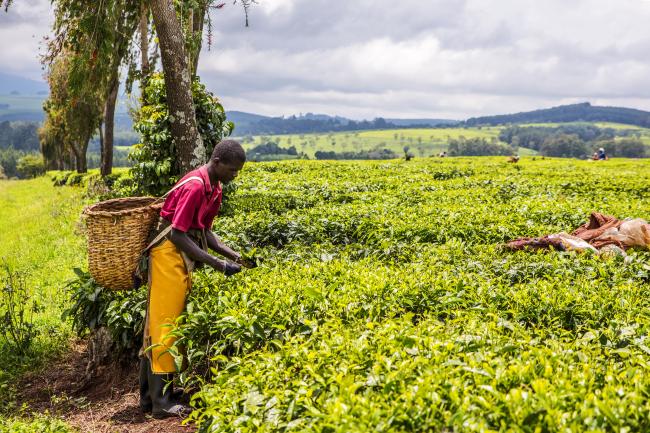
By Peter McConaghy and Nancy Widjaja
In Kenya's agricultural sector, a significant transformation is underway, led by digital innovation and strategic partnerships. This blog delves into the Agricultural Exchange initiative, spotlighting its role in enhancing financial inclusion for smallholder farmers. The exchange is a key initiative of the CEO Partnership for Economic Inclusion (CEOP), a collaboration convened by H.M. Queen Máxima of the Netherlands, in her capacity as the United Nations Secretary-General’s Special Advocate for Inclusive Finance for Development (UNSGSA).
Kenya's Financial Inclusion Landscape and Agricultural Technology
Kenya, renowned for being the birthplace of the mobile money revolution, has witnessed remarkable growth in financial access. Over the past 12 years, the percentage of adults with accounts has risen from 42% in 2011 to 79% in 2021, according to the latest World Bank Global Findex. Despite impressive growth in account penetration, recent trends depict a concerning decline in financial health among Kenyans, with an increasing number forgoing necessities like meals and medicine, and facing educational disruptions due to unpaid school fees, as reported by FinAccess in 2021. Concurrently, climate volatility is intensifying, affecting approximately 3 million Kenyan adults in 2021, a rise from 2.4 million in 2019.
The agricultural technology (ag-tech) sub-sector stands out, with financial service providers and technology companies innovating by redesigning insurance markets through technology and bundled services, supporting agroforestry transition through carbon removal units, and developing digital platforms supporting market access and productivity tools for smallholder farmers. These interventions are critical given the sector's substantial contribution to GDP (over 33%) and employment (over 40%) (data from USAID 2023). Ag-tech is emerging as a key ally in the face of escalating economic and climate adversities. A mere 5% of Kenyans utilize formal financial strategies to combat climate-related risks, with the majority depending on informal support from family and friends, selling assets, and cutting expenses.
The Kenya Agricultural Exchange
During her October 2023 visit to Kenya, H.M. Queen Máxima of the Netherlands, the United Nations Secretary-General’s Special Advocate for Inclusive Finance for Development (UNSGSA), observed the impactful collaboration from a unique partnership between Mastercard, Rabobank, and the Co-operative Bank of Kenya. Together, these companies established a digital agriculture marketplace designed to provide transparent information for buyers and smallholder farmers, in addition to access to finance support, called the Agricultural Exchange. The initiative was launched in 2019 as one of 10 projects in the CEO Partnership for Economic Inclusion (CEOP) convened by UNSGSA Queen Máxima.
At its core, the exchange is a pioneering platform providing a digital marketplace where buyers and smallholder farmers converge for trade. There is an emphasis on accurate and transparent information leading to more sustainable incomes and economic resilience for farmers. The Co-operative Bank is providing credit to farmers group, while Rabobank is leveraging a data-driven credit analytics model to facilitate alternative credit scoring.
The platform builds upon Mastercard’s digital solution, Farm Pass, and Rabobank’s extensive experience in agri-financial services across Europe, Africa, and Asia. The Co-operative Bank has been instrumental in the exchange’s success, integrating 700,000 farmers into the digital marketplace via its expansive network of agricultural cooperatives.
The ambition of the Agricultural Exchange extends beyond its current focus. By 2024, it aims to replicate its innovative model in Nigeria, Uganda, and Tanzania. With a global objective to engage 5.9 million farmers by 2025, the exchange is poised to facilitate $2.58 billion in transactional volume and extend over $291 million in loans, marking a significant milestone in the digital transformation of agriculture.
Forward Look: Strategic Questions to Support Model, Scale, and Impact
While policymakers foster market development through improved regulation, investments in financial infrastructure, and risk mitigation instruments, the impetus lies with the private sector to advance market innovations.
The Kenya Agricultural Exchange offers a nascent yet promising model of private-sector partnerships to promote the livelihoods of smallholder farmers. It builds on the impressive reach and technical resources of the three partner institutions and capitalizes on digital solutions to bolster agricultural supply chain efficiencies.
For the enduring success and integrity of such collaborations, a continued emphasis on three areas is essential:
1. Measuring Real-world Effects: It is vital for the partners involved to keep a close eye on the actual benefits the platform brings to farmers' lives. This means not just counting the number of users or transactions, but really understanding if farmers are better off because of the platform — are they making more money, handling tough times more easily, or growing their farms more efficiently? To get the full picture, they might collaborate with researchers who specialize in studying these kinds of impacts.
2. Sustainability and Scale: It is important to figure out what needs to happen for this initiative to grow in a way that is responsible and lasting. This is more than just making sure it is financially stable; it is about ensuring that the partnership keeps providing real value, not just as a corporate social responsibility initiative but as something that can stand on its own and make a difference in the long term. The aim is to create a model that is good for business and society, and that can be set up in other places too, benefiting more farmers.
3. Listening to Farmers: When designing digital tools like this exchange, it’s crucial to consider what life is really like for the farmers who will use it. This includes the challenges they might face, such as spotty internet access, learning how to use digital tools, or balancing farm work with other daily responsibilities — especially for women. By putting the needs and experiences of farmers at the center of the design process, the platform can be made more valuable and easier to use. Additionally, it’s key to ensure that there are strong protections in place to keep users’ information safe and to prevent any kind of financial fraud.
About the Authors
Peter McConaghy and Nancy Widjaja are policy advisors at the Office of the UNSGSA.